Bleakstone is my old school fantasy hexcrawl setting, parts of which have been kicking around in my brain since 2012. This post presents an overview, including an elevator pitch and all the high notes.
In August of 2014 I finally realized that I do best when I design gaming stuff in chunks, rather than trying to eat the whole elephant, and decided that the easiest way to do that with Bleakstone was also to design the setting in public. It’s been through numerous iterations (not all of them named Bleakstone), it’s full of things I like in my D&D, and it’s a work in progress.
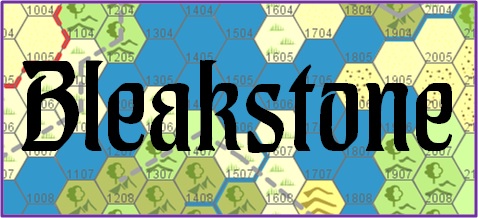
This post is focused on presenting concise, gameable content that sparks my imagination — the bare minimum that I need to sit down and referee a Bleakstone campaign. You can jump straight to specific sections if you like: regional map, dominant intelligent species, unique features, domains, and inspiration and tools.
Spoilers for players abound
If you’re a player in Bleakstone, or think you might one day like to play in this setting, stop reading here. There’s no segregation of player and GM content below, and Bleakstone’s secrets are laid bare below.
Bleakstone elevator pitch
Strange, chaotic, and dangerous, the region known as Bleakstone has nonetheless produced pockets of stability and civilization in the past few centuries. Towns and villages dot the land, often fortified, and petty fiefdoms and principalities claim territory throughout the region. But in between, on Bleakstone’s poorly maintained roads — and beyond them — are dark, dangerous places peopled by monsters, centuries-old ruins and dungeons, scheming null slimes, the hidden domains of spider-like skurliths, the spires of imprisoned gharrudaemons, and wandering uzbardim who answer to no one.
In its golden age, a civilized skurlith empire ruled this entire region. The skurliths pacified the land by imprisoning the gharrudaemons who came before them, entombing them in vast obsidian monoliths that still stand today. Bleakstone is best known for the areas of “bleak stone” that dot the landscape: places that have been petrified in their entirety, and which are peopled by denizens of hell — and worse. These stone expanses range from a few yards in size to several miles in diameter, and within them it’s as if everything present was transformed into stone in an instant: people, animals, plants, houses — anything in contact with the ground. The bleak stone expanses began appearing a few decades ago, and new ones have appeared ever since. They’re mysterious, unpredictable, and above all dangerous places, avoided by most residents of Bleakstone.
Declared an “unholy land” by the Holy Empire of the Eleventh Lord, to the west, a decade ago (and stricken from all maps produced by the Empire), Bleakstone is largely ignored by its neighbors. Bleakstone is a weird and troubled land, a place where adventurers have many opportunities to make their mark — and many more opportunities to die trying.
Regional map
The Bleakstone region is represented by a 30×20 map composed of 6-mile hexes numbered 0000 through 2919, 600 hexes in all, with a surface area of about 19,200 miles. It’s about the size of Costa Rica, although I didn’t plan that — I picked 30×20 because it fit nicely on my monitor, offered plenty of room, wasn’t so large as to seem impossible to flesh out, and made it easy to randomly place locations with a d30 (long axis) and a d20 (short axis).
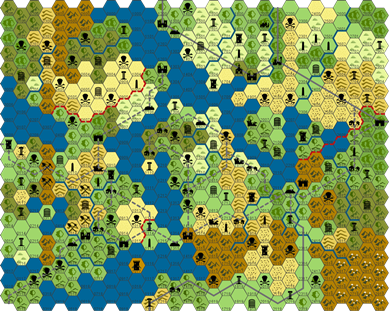
Here’s a much larger version of the map — a full-size export straight from Hexographer.
Climate
All of Bleakstone is temperate and has four distinct seasons. It’s broadly similar to western Europe.
Dominant intelligent species
There are five dominant intelligent species in Bleakstone. In order of population, most to least, they are:
- Humans
- Skurliths (“skuhr-liths”)
- Uzbardim (“ooze-bahr-dimm”)
- Null slimes
- Gharrudaemons (“garr-oo-day-mons”)
Elves, dwarves, and halflings are also present in Bleakstone, but they’re relatively uncommon and aren’t dominant in the region.
Humans
When the skurlith empire fell, humans moved in like rats, as they always do, and quickly became the most common species in the region. They found a strange landscape dotted with towering obsidian spires and peopled by mysterious uzbardim and the remnants of the skurlith race. Later, they learned of the null slimes and became embroiled in their intrigues (and vice versa). The more susceptible among them became cultists of the gharrudaemons. In this strange land, the strong tend to rule — those whose ambition and avarice dull their caution, and who could not rule in more civilized lands.
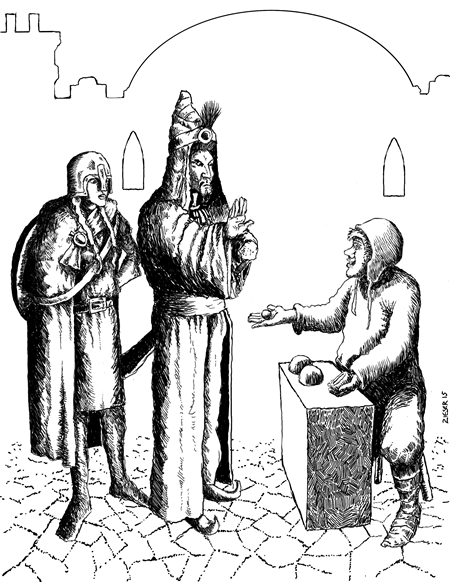
Most humans in Bleakstone were born in one of the three human domains that span the region: Skeldmar (feudal Germany with a Norse flavor), the Blackfang Barony (a dirtier version of medieval England), or the Theocracy of Umr (a blend of sword and sorcery, fantasy Arabia, and religious madness). People of Umr tend to be tall, with medium-brown skin and pinched features. Skeldmar folk tend to be shorter, and most often have pale skin, light-colored hair, and wide faces. The ancestors of the people of the Blackfang Barony were a mix of exiles and castoffs from other nations, and their descendants run the gamut from dark-skinned to light-skinned, with a wide variety of features. Over the centuries, wanderers from all over have found their way to Bleakstone, and people of all shapes and colors can be found in the region.
Skurliths
Once the dominant species in Bleakstone, Skurliths are now the bogeymen of the region — the savage, degenerate descendants of a once-proud species whose civilized empire spanned all of Bleakstone. About three feet tall when standing on two legs, their ungainly bodies appear to be made entirely of hairy sinews and chitinous plates. They have shiny black crab heads, two spider-like forearms tipped with pincers, and eight smaller pale, claw-tipped legs, the lower two of which are larger and thicker than the others, enabling them to walk upright. They prefer to scuttle on all of their legs, moving like a cross between a spider and a centipede.
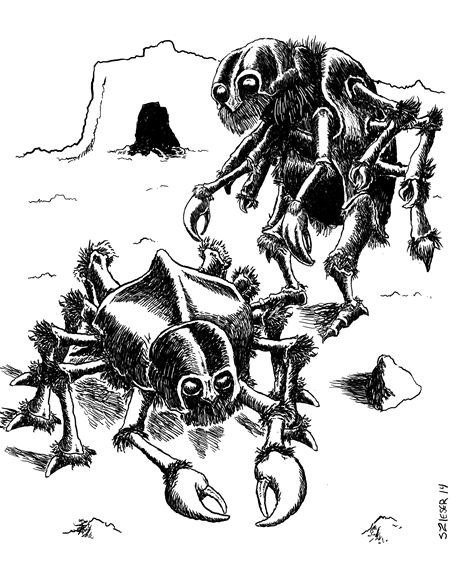
Skurliths no longer have a formal culture or society, instead grouping along cult lines: All skurliths in a given area worship some aspect, often half-remembered, of their foul goddess, and perform dark rites in their subterranean lairs. Ruined cyclopean monuments to the Lady of a Thousand Pincers dot the wilderness, as do the towering obsidian monoliths erected by their distant ancestors, but the cults are the only aspect of old skurlith society that survive among the creatures themselves. They often make their homes near reminders of their former greatness, though they never go near the obsidian pillars.
Skurliths lair in dry warrens a few feet underground, and they hunt like trapdoor spiders. A typical skurlith lair has numerous concealed entrances, each covered by a camouflaged trapdoor, with skurliths waiting just below the trapdoors for prey to come close enough to grab. They’re also skilled trackers, capable of stalking prey across long distances.
Uzbardim
Uzbardim are expressions of chaos from another dimension, each a living cog in a great pattern designed to bring about the Third Transformation. They are bipedal, but in place of feet they have bundles of fibrous tentacles which can bunch together (when wearing shoes, for example) or separate to navigate uneven terrain. Their torso is shaped like a capital letter “T,” with two arms dangling from each end of the long ridge that forms their shoulders. Their heads are set level with their shoulders, on the front of the torso; they have one huge, red eye, but no other facial features. Uzbardim’s bodies are always stark white, and their flesh is unpleasantly spongy, but resilient.
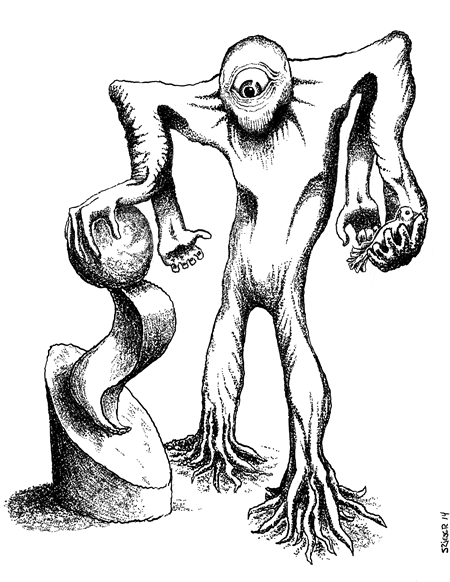
Their actions appear unpredictable to others, but everything an uzbardim does is part of their shared grand plan. How they communicate with each other is unknown; though they can make hooting and moaning sounds, they generally communicate with non-uzbardim only through gestures. Uzbardim interact with other intelligent beings only when their agenda overlaps with the boundaries of society. In some places they live in villages, creating bizarre sculptures and crooning nonsense language; in others, they live alongside humans and work as thieves, spies, and scouts; and in still others they wander, apparently aimlessly, and attack anyone who comes near. They are birthed from giant seed-pods found near water.
Null slimes
Null slimes are greyish blobs about 8-12 feet in diameter and roughly a foot thick in their resting state. They live underground, and when in motion they “pool” against a surface and secrete a weak acid that eats through rock and dirt, enabling them to tunnel slowly but ceaselessly, honeycombing the earth. A null slime can form a vocal apparatus that enables it to make moaning noises, mimic animal speech, or — if intelligent — to speak.
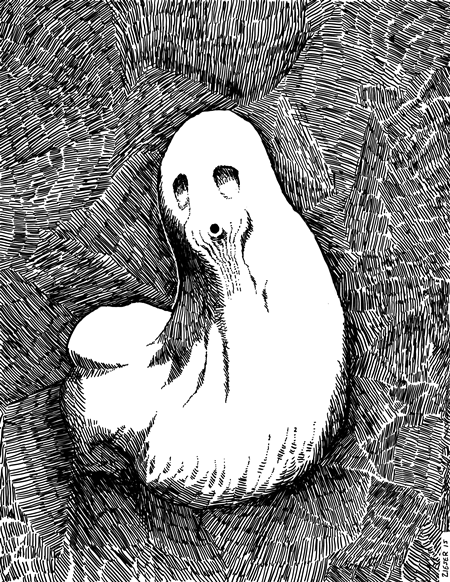
Around 90% of null slimes are unintelligent — peaceful, cow-like creatures content to tunnel and follow the orders given to them by the other 10%. That 10% is composed of some of the most intelligent and devious creatures in Bleakstone: plotters, assassins, schemers, living siege-weapons, seekers of secrets, messengers, and carvers of underground byways used by even darker creatures. They’re as peaceful as their unintelligent cousins only in the sense that they rarely commit violence directly, instead manipulating others to act on their behalf.
Null slimes have no name for their own species; “null slime” is simply the moniker that stuck. The intelligent ones worship the Absence, and view voids of all kinds — the tunnels they leave behind, the absence of life caused by murder, the power vacuum created by an assassination — as sacred. Many of their sinister plans seek to bring about nothingness in some form. They’re justly feared throughout Bleakstone.
Gharrudaemons
Centuries ago, rifts in reality began to appear in what is now Bleakstone. Through these rifts came gharrudaemons, lords of hell with powerful magical abilities. The skurlith empire fought the gharrudaemons and eventually imprisoned them, and sealed the rifts, inside vast obsidian monoliths. These monoliths still stand today, towering high into the sky.
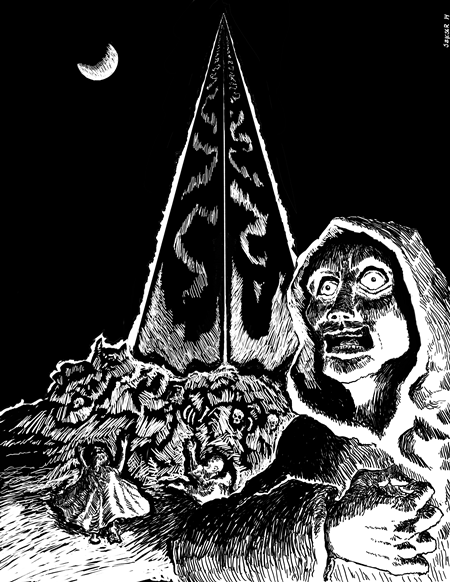
While the gharrudaemons cannot escape their monolith-prisons, nor return to hell through the rifts, they can communicate with the outside world through telepathy. Over several centuries they have preyed upon weak minds, building up cults of mortal worshipers around their monoliths. During dark rites enacted at the bases of their spires, the gharrudaemons direct their followers to do their bidding. Some gharrudaemon cults are small and relatively localized, while others are subtle and insidious; the latter have worked their way into Bleakstone society, extending their masters’ reach ever wider.
Gharrudaemons have their claws in a great many pies across Bleakstone, manipulating mortals and seeking to shatter their prison spires. If successful, they would sweep across the land like a hell-scourge.
Dwarves, elves, and halflings
Dwarves, elves, and halflings are all relative newcomers to Bleakstone. Dwarves are most often found deep in Bleakstone’s mountains, expanding their slowly growing network of tunnels and keeping largely to themselves. Several clans from neighboring regions can be found here. Dark rumors persist that Bleakstone dwarves traffic regularly with null slimes.
Elves skulk in the region’s woodlands, spying on humans and developing detailed maps of Bleakstone for their masters in the northern nation of Seven Trees. They can’t be trusted, but they know more about some aspects of Bleakstone than anyone else in the region. Elves are always after more information about the region and its inhabitants, and will often trade their knowledge for new intelligence.
Halflings tend to be adventurers or traders, and are most common in coastal communities. Most Bleakstone halflings are part of the same sprawling crime family — a literal family of siblings, cousins thrice removed, and half-uncles, as well as a Mafia-style organized crime ring. Halflings boil their dead, extract the bones, and display the skeletons of venerated elders in their homes. What they do with the meat is anyone’s guess.
Unique features
Coupled with its unusual dominant species, three major features of the Bleakstone region set the place apart as weird and dangerous.
Bleak stone expanses
A bleak stone expanse is an area that has been “flash-petrified” in its entirety. They began appearing about 30 years ago, and new expanses are still appearing today. No one knows what causes them, but they terrify the average Bleakstone resident. They’re home to devils, demons, and worse, and are the source of countless local legends.
Some are pristine, with people turned to statues mid-conversation, cows petrified in their fields, and everything untouched save by weather. Others have been vandalized, turned into refuges by desperate bandits, or even broken up so that their peculiar stone can be sold to wizards in far-off lands. The only good news is that once an expanse appears, its borders are fixed — it will never grow any larger.
Obsidian monoliths
The landscape is dotted with massive spires of obsidian, apparently solid, all at least a hundred feet tall (and some much taller; the largest is over 400 feet high). Every one of them imprisons a gharrudaemon, making the regions around them dangerous: Cults worship the daemons, the beasts themselves reach out telepathically to exert their will on the surrounding area, and spending too long near a monolith causes mutations in people and animals. The existence of gharrudaemons (and the rifts through which they came), or indeed the monoliths’ status as prisons, is unknown to the overwhelming majority of Bleakstone’s inhabitants.
Ruined skurlith monuments
No one knows why the skurlith empire fell, nor why its descendants became savage, degenerate creatures, but the skurliths’ enormous, cyclopean monuments still stand today. All venerate their foul goddess, the Lady of a Thousand Pincers, in some way, but each is unique in its loathsomeness. The largest skurlith domains are located near these monuments.
Domains
Bleakstone is divided into four domains, with their borders indicated by dotted red lines. The Blackfang Barony, extending east from the center of the map, is the largest domain; Harrowmoor, an unclaimed region that’s home to many uzbardim, is the smallest. The Theocracy of Umr occupies the northeast quadrant of the map, while Skeldmar spans the western edge and extends into the center of region.
Blackfang Barony
Map location: center and lower right | Collective noun: “Blackfangs”
Ruled with an iron fist by the self-styled Baron Dragos Blackfang, a noble from a northern kingdom exiled for his depravity, the Blackfang Barony looks like feudal England, only dirtier—and with uzbardim. For unknown reasons, uzbardim are common here, and most of them work as slave laborers alongside the barony’s human serfs. Aristocrats and notables dye their teeth black to signal their loyalty to the baron, while its peasants are forced to wear black hoods as a sign of their fealty. Some of the most fertile land in the region lies within the barony’s borders, and the baron’s power owes much to the farms tilled by his serfs. Null slimes have a significant presence as well, manipulating events in the barony and in neighboring Umr.
Harrowmoor
Map location: upper left | Collective noun: “Moorfolk”
Harrowmoor is the closest thing to a uzbardim nation anywhere in the region, as more uzbardim live here than anywhere else, pursuing their own mysterious ends. As they have no organized social structure, Harrowmoor is officially unclaimed territory, poor in natural resources but rich in brigands, dungeons, and monsters. Skurliths can be found throughout Harrowmoor, and are a constant danger to travelers. Bands of scum and exiles make their home here, striking out into neighboring Skeldmar to raid and pillage before melting back into the desert and mountains of Harrowmoor. Nomadic uzbardim also roam Harrowmoor, camping in one spot for a few days while robbing travelers, and then moving on to a new camp. Scouts, spies, and smugglers use Harrowmoor like a highway to travel between kingdoms without being detected. Both Skeldmar and the Blackfang Barony would like to annex Harrowmoor, but none has yet been able to stake and defend a claim.
Skeldmar
(“skelld-mahr”) Map location: middle and lower left | Collective noun: “Skeldmarians”
Much like feudal Germany, but with a Norse flavor, Skeldmar is a patchwork nation composed of dozens of tiny fiefdoms, each ruled by a skeld who pays obeisance to the king but in practice is largely left alone. Every community in the region has its own skeld, and every skeld wants to rule a larger area than she already does. Justice is delivered through trial by combat, and duels are commonplace. In truth, nearly all of Skeldmar is ruled by null slimes, who manipulate the skelds through control of the kingdom’s many mines (its most important resource). To outsiders, it often seems like everyone in Skeldmar is out to make a name for themselves any way they can.
Theocracy of Umr
(“oom-urr”) Map location: upper right | Collective noun: “Umrians”
The oldest human nation in the region, the theocracy is governed in the name of Umr-Khall, the One God, the Lord of Magic. For the average Umrian, that means paying at least lip service to Umr-Khall’s cult—and being constantly paranoid that you’re not doing enough, and that the Pale Wardens (Umr’s secret police) will make you disappear in the night. Few Umrians know that the theocracy is actually ruled by the gharrudaemon Nuzzurkalioth. Many of the acolytes of Umr-Khall’s cult are really worshipers of the gharrudaemon, and their ranks are always increasing. Umr is like a cross between fantasy Arabia and feudal Russia, a hard land of dark secrets, cruel nobles, and strange magic.
Background, credit, and tools
My approach to creating Bleakstone was based on three things:
- A randomly generated Hexographer map, with a few tweaks. I generated maps until I hit one that felt right, and that became the basis for the region.
- Randomly placed towns, dungeons, and other features, with some non-random additions. I didn’t use How to Make a Drop Map for this iteration of the setting, but that approach informed the simpler one that I did use: I rolled a d30 for the long axis and a d20 for the short axis, juggling the results as needed. I then added things by hand until it felt right.
- Random selection of dominant intelligent species based on Random Campaign Setting Major Races, mashed up with Proscriptive Campaign Creation. I used the Fiend Folio (my favorite monster book) when I rolled for dominant intelligent species, and I got denzelians, meenlocks, nycadaemons, and tiraphegs. They were the inspiration for the null slimes, skurliths, gharrudaemons, and uzbardim that are the foundation of Bleakstone.
The central idea that gave the region its name was inspired by the Lamentations of the Flame Princess module Death Frost Doom, which features an unexplained petrified area. (I no longer support LotFP, but this acknowledgement remains because I’m a big believer in acknowledgements.) Bleakstone’s other inspirations are harder to catalog because they span dozens of books, blogs, G+ posts, and a host of stuff I’ve read or bumped into over the years. A few sources stand out clearly, though:
- Tales of the Grotesque and Dungeonesque, and its associated books. Jack Shear writes some of the tightest, most immediately gameable setting material in the business.
- Appendix N, and my own Reading Appendix N project, most notably Robert E. Howard’s Conan yarns, Fritz Leiber’s Fafhrd and the Gray Mouser tales, and H.P. Lovecraft’s yog-sothothery.
- James Maliszewki’s Grognardia, which introduced me to so much old school awesomeness.
- Patrick Wetmore’s Anomalous Subsurface Environment, which jams a huge amount of gonzo goodness into a cruft-free package.
- Early Dark, from Anthropos Games, which introduced me to the idea of mashing up Earth cultures to create fantasy nations
- Warhammer Fantasy Roleplay, 1st Edition, which got me into old school British fantasy
- Abulafia‘s fantastic random generators
The ever-awesome Steve Zieser illustrated Bleakstone’s iconic species.
Lastly, the Bleakstone logo font is CAT Hohenzollern, designed by Peter Wiegel.
Legal stuff
Bleakstone and the Bleakstone logo are trademarks of Martin Ralya. The Bleakstone campaign setting, including all artwork, is copyright 2014 by Martin Ralya. All rights reserved.
If you dig Bleakstone, I encourage you to use it in your home game, in whole or in part, provided it’s not published or distributed in any form. Happy gaming!

Very cool! Glad you’re posting this for all to see. :)
It’s been really nice to get it out of my head and into words. I’m looking forward to adding to it!